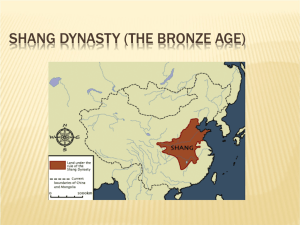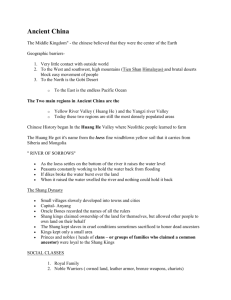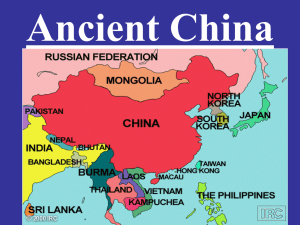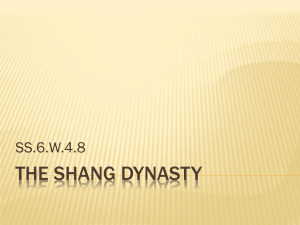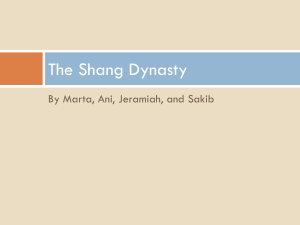Shang Dynasty
advertisement
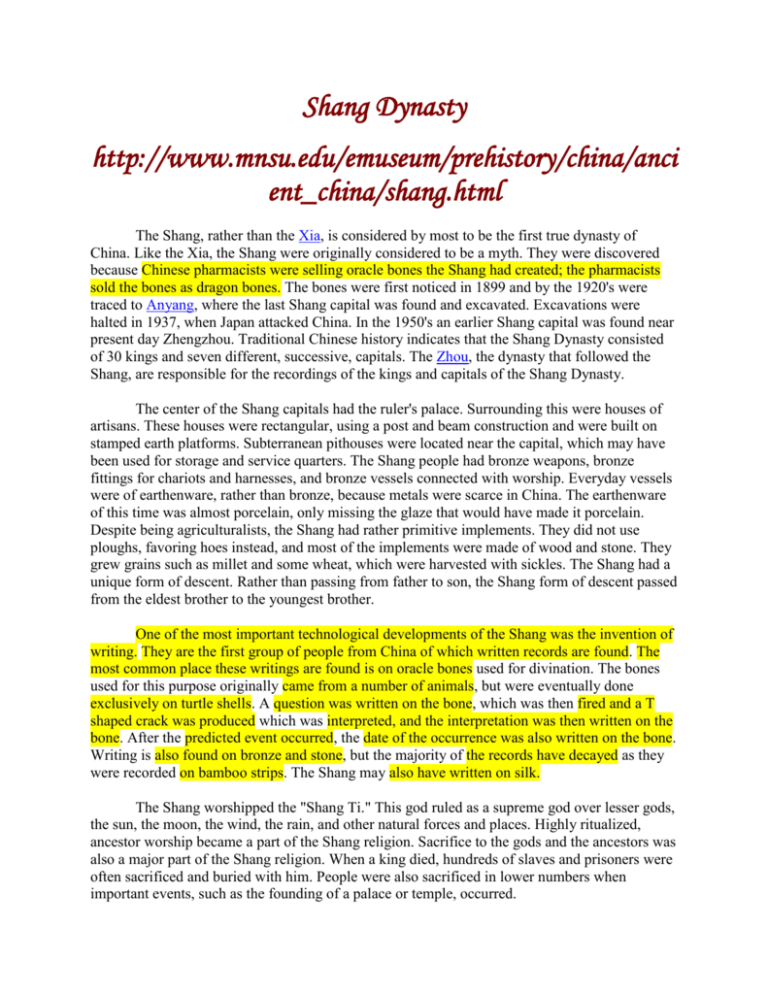
Shang Dynasty http://www.mnsu.edu/emuseum/prehistory/china/anci ent_china/shang.html The Shang, rather than the Xia, is considered by most to be the first true dynasty of China. Like the Xia, the Shang were originally considered to be a myth. They were discovered because Chinese pharmacists were selling oracle bones the Shang had created; the pharmacists sold the bones as dragon bones. The bones were first noticed in 1899 and by the 1920's were traced to Anyang, where the last Shang capital was found and excavated. Excavations were halted in 1937, when Japan attacked China. In the 1950's an earlier Shang capital was found near present day Zhengzhou. Traditional Chinese history indicates that the Shang Dynasty consisted of 30 kings and seven different, successive, capitals. The Zhou, the dynasty that followed the Shang, are responsible for the recordings of the kings and capitals of the Shang Dynasty. The center of the Shang capitals had the ruler's palace. Surrounding this were houses of artisans. These houses were rectangular, using a post and beam construction and were built on stamped earth platforms. Subterranean pithouses were located near the capital, which may have been used for storage and service quarters. The Shang people had bronze weapons, bronze fittings for chariots and harnesses, and bronze vessels connected with worship. Everyday vessels were of earthenware, rather than bronze, because metals were scarce in China. The earthenware of this time was almost porcelain, only missing the glaze that would have made it porcelain. Despite being agriculturalists, the Shang had rather primitive implements. They did not use ploughs, favoring hoes instead, and most of the implements were made of wood and stone. They grew grains such as millet and some wheat, which were harvested with sickles. The Shang had a unique form of descent. Rather than passing from father to son, the Shang form of descent passed from the eldest brother to the youngest brother. One of the most important technological developments of the Shang was the invention of writing. They are the first group of people from China of which written records are found. The most common place these writings are found is on oracle bones used for divination. The bones used for this purpose originally came from a number of animals, but were eventually done exclusively on turtle shells. A question was written on the bone, which was then fired and a T shaped crack was produced which was interpreted, and the interpretation was then written on the bone. After the predicted event occurred, the date of the occurrence was also written on the bone. Writing is also found on bronze and stone, but the majority of the records have decayed as they were recorded on bamboo strips. The Shang may also have written on silk. The Shang worshipped the "Shang Ti." This god ruled as a supreme god over lesser gods, the sun, the moon, the wind, the rain, and other natural forces and places. Highly ritualized, ancestor worship became a part of the Shang religion. Sacrifice to the gods and the ancestors was also a major part of the Shang religion. When a king died, hundreds of slaves and prisoners were often sacrificed and buried with him. People were also sacrificed in lower numbers when important events, such as the founding of a palace or temple, occurred. The Shang king had considerable power over his subjects. Public works were built that required many people. The capital at Zhengzhou, for example, had a wall of stamped earth around it that was four miles long and up to 27 feet high in areas. Stamped earth walls were made by pounding thin layers of earth within a movable wooden frame. The earth then becomes as hard as cement. The calendar is closely related with the development of the astronomy. As far as 5,000 years ago, China had the lunisolar calendar, which indicated that each year had 366 days. In the Shang Dynasty (1600-1066BC), officials were appointed to bear the sole task of observing and recording the changes in the heavens. During this period, people used the lunisolar calendar, with an intercalary added to the end of certain years. Oracle Bones: To communicate with their ancestors, the Shang kings used oracle bones (sometimes called dragon bones). The king or emperor would ask a question, for example, will it rain tomorrow? The priest would carve the king's question on an oracle bone, which was just an animal bone or turtle shell. (Will it rain tomorrow?) Then, the priest would heat a bronze pin and hold the hot pin to the bone. This created a pattern of cracks over the bone. The priest (who was usually a woman) would study the cracks to find the answer to the question. Archaeologists have found over 100,000 oracle bones. Since many questions were asked about daily life, we know something about this civilization. The thing is, they didn't exactly ask "Will it rain tomorrow?" Oracle bones say things like: "If we sacrifice 10 men or 5 oxen, will it rain tomorrow?" The Shang kings sacrificed a great number of people to talk to their ancestors. Some of those sacrificed were enemies, captured in war. Some were slaves or people who were sick or deformed. Some were merchants, craftsmen, or farmers who had upset the nobles. Some were nobles who had upset the king. http://china.mrdonn.org/oraclebones.html
